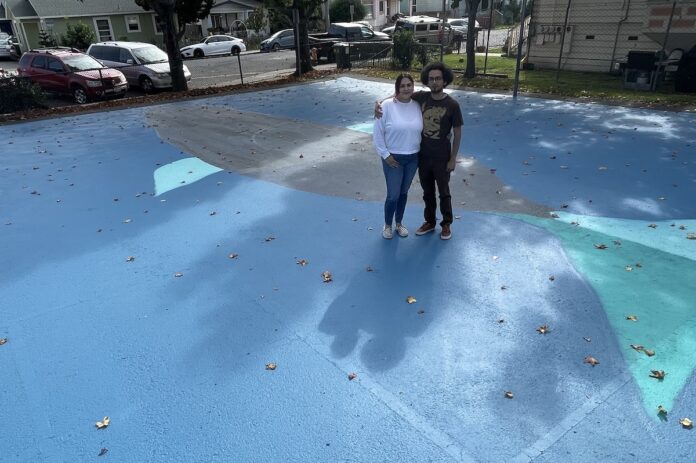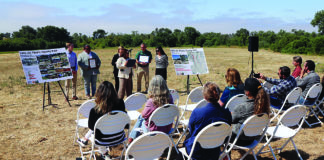WATSONVILLE—Watsonville artist Augie WK for two years has dreamt of bringing a humpback whale to life at the Marinovich Community Center.
It was 2019 when the upstart muralist was approached by Watsonville Environmental Science Workshop coordinator Darren Gertler and asked if he’d be interested in using his talents to splash some art onto the downtown park.
The plan, WK says, was to paint a 50-by-54-foot mural of a humpback whale on a basketball court at the park. The art piece, he says, would not only highlight ocean conservation but the migratory path that the whales take along the California coast and down into Mexico—a parallel to some of the city’s residents that is not lost on WK and his partner Jessica Carmen, who was born and raised in Watsonville.
After gaining approval from the Watsonville Parks and Recreation Commission in mid-October, it seemed like his dream would come true. But for more than a month, he and Carmen had to cease work on their project as they awaited administrative approval of their proof of liability insurance—a stipulation that they say was not made clear when they submitted their application.
WK says they submitted their paperwork to the city on Nov. 11. They received approval to resume work last week and restarted painting on Dec. 3.
Before the work stopped, the mural was less than a quarter of the way done. And without a coat of sealant, the winter weather and typical wear and tear took their toll on some two weeks of work they had sunk into the project—work that they were initially not being paid for, even though they were first told by Gertler they would likely be compensated.
“When they said they wouldn’t pay us for it, I just said this would be our gift to the city, our gift to the community,” WK said during an interview on Nov. 8. “Even then, we’ve hit a ton of hurdles.”
Comeback story
Parks and Community Services Department Director Nick Calubaquib says that the situation at the park is a result of miscommunication between the city and the artists. WK and Carmen, Calubaquib says, began their work before the two parties had an agreement—and proof of insurance—in place. Because of this, the city told the artists to cease work.
“When we first received their insurance, the name on the certificate of insurance did not match the names used on the agreement, so we had to make adjustments,” Calubaquib said in an email. “There was also some confusion regarding artist and materials fees that we have since clarified. We are waiting on a final approval signature from the City Manager’s Office and they will be good to go. We are looking forward to seeing the final product.”
It is not the first time WK and Carmen have had a dispute with the city over an art piece. Two years ago, they got into a quarrel while painting a mural on the side of Don Rafa’s Supermercado off Riverside Drive. The issue then was that they began painting without a permit, and without any approval from the city—they say they contacted the city multiple times about the project but did not receive any response. That disagreement was eventually resolved, and the “Sabor” mural at the Mexican food market shines brightly to this day.
When asked why they would come back to paint another mural after their first experience with the city, Carmen says that the work the Watsonville City Council has done to promote art gave her hope that their second project would run much smoother. An employee with Arts Council Santa Cruz County, a nonprofit that promotes art and distributes thousands of dollars in grants to local artists, Carmen says that the “behind the scenes” movement that she had seen in her hometown was promising.
“I was like, ‘Great. They’re all on board. We’re all moving toward the same goal of having the arts be a pillar of the community,’” Carmen said. “In my head, I was like ‘there’s no way they’re going to hinder us this time because this is what they want.’ When this happened, I was like ‘Woah, I thought we were on the same page.’”
Action plan
The behind the scenes action Carmen was referring to is the city’s public art program. The first phase of that initiative was approved by City Council just a few months after their squabble with the city over the “Sabor” mural. There are two phases to the program. The first phase dealt with public art funded by private companies, grants or donations, and it established an approval process that artists would need to follow to lawfully showcase their work.
Calubaquib says the first phase of the program has been an overwhelming success. He estimated that the Parks and Recreation Commission has approved one or more art projects per month since the program was introduced. On top of that, having artists present their work to the commission in a public meeting has given the community an opportunity to have a say about the art that is showcased in their city.
Calubaquib highlighted the ongoing “Watsonville Brillante” mosaic on the Civic Plaza parking garage, the newly-installed murals honoring disabled athletes at Ramsay Park and the strawberry mural on the intersection of East Lake Avenue and Brennan Street as success stories.
“It’s neat to see how things have grown in certain ways,” he said.
Phase 2 of the program, Calubaquib says, is where things get “really exciting.”
The city plans to set up a sustainable funding source for public art—both visual and performing—by establishing a “percentage for the arts” fee. Calubaquib says that staff is proposing developers pay 1.5% of their overall project costs into an account with the sole purpose of funding city-initiated public art. If the fee is greater than $75,000, Calubaquib says, the developer could choose to add a public art piece to their project in lieu of paying the fee.
The fee would require City Council approval. It is unclear when the item would go before the elected leaders for consideration.
If approved, Calubaquib says the funds raised could help spur an art revolution in Watsonville. Along with funding singular projects and paying artists to perform the work, the money could also help create a public art master plan, or provide funding for a community-run arts center.
Calubaquib says that these fees are nothing new. Other cities have for years charged developers this fee and reinvested those dollars into their arts community. While developers might see the fee as another hurdle to completing their projects in an already pricey construction market, Calubaquib says that fees that go toward public art, “unlike any other fee, really have an impact on quality of life.”
“I’ve always been appreciative of art but I’ve really become an even bigger supporter of public art through this whole process,” Calubaquib said. “Public art really helps to create spaces and create an atmosphere where our community voices can be heard and seen in a way that you can’t do in any other way.”
Art-conomics
Carmen and WK say they wholeheartedly agree with Calubaquib on the power of art, and they hope that the city will follow through on the second phase of its public art program sooner rather than later. They also hope the city will refine its approval process, and hire someone to deal specifically with artists looking to create public art.
“And, at the end of the day, they should pay artists,” Carmen said.
She says that investing in the art community could be an economic catalyst for the city. Along with pointing to large tourist hubs like Austin, Texas, Los Angeles and San Francisco, Carmen also highlighted a recent mural festival in Sand City that reinvigorated a mostly barren area of the small municipality.
“It’s proven that art creates economic growth,” Carmen said. “Watsonville is a little bit behind on that … It’s starting to catch up a little bit, but Watsonville is like the last city on Central Coast that’s catching on to the idea that the arts can bring prosperity, it can build community, it helps people in underserved and neglected communities … That’s kind of our whole thing. Yeah, we want to paint the murals but we also want people to actually understand the impact that murals have on the community and on a community’s identity.”
On top of that, WK says, they want to show young Watsonville residents that they, too, can become artists. Born in Salinas and raised in Gonzales, WK says that he was inspired to become a muralist when he came across an art piece in Gonzales. To this day, he does not know who created the mural that “spoke to” him, but he said that he knew immediately that he wanted to be an artist because it gave him a chance to give back to the community and “live forever.”
“If I had that moment of seeing a muralist at work as a child, I think I would’ve started sooner,” he said. “It happens all the time. Little kids get really inspired [when they see us painting] and it’s really heartening.”
For information about the city’s public art program, visit cityofwatsonville.org/1854/Public-Art. To see more art from Augie WK, visit his Instagram page: @augiewk.
[This story has been updated to show that the artists are indeed being paid for their work. — Editor]











